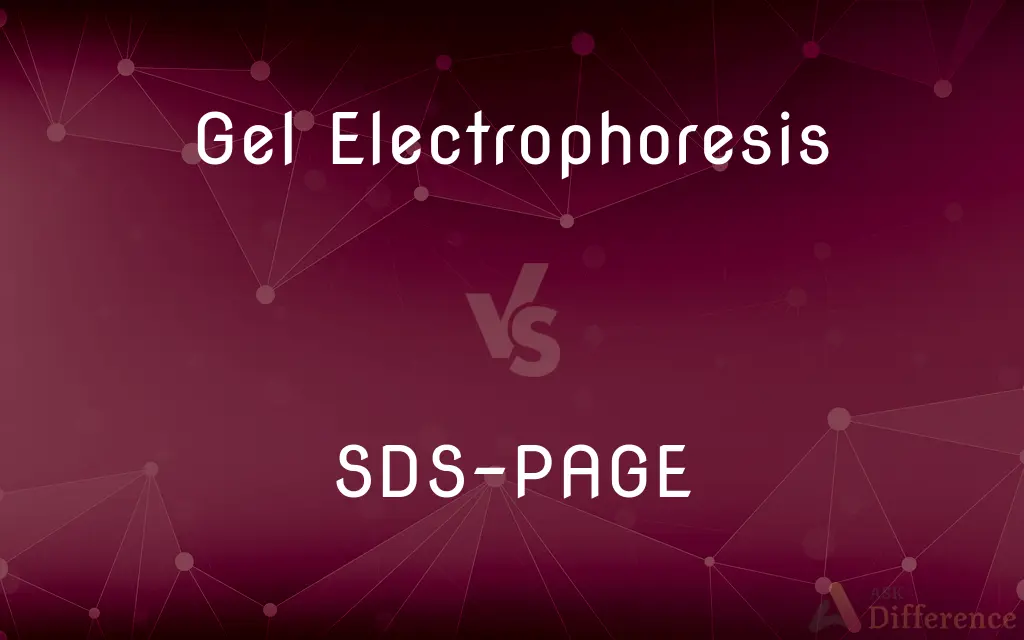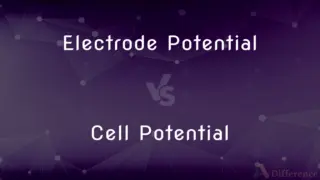Gel Electrophoresis vs. SDS-PAGE — What's the Difference?
By Tayyaba Rehman — Published on January 18, 2024
Gel electrophoresis is a method to separate DNA, RNA, or proteins based on size and charge, while SDS-PAGE specifically separates proteins based on size.

Difference Between Gel Electrophoresis and SDS-PAGE
Table of Contents
ADVERTISEMENT
Key Differences
Gel electrophoresis is a laboratory technique used to separate DNA, RNA, or proteins based on their size and charge by applying an electric field. The molecules migrate through a gel matrix, with smaller fragments moving faster. SDS-PAGE, or Sodium Dodecyl Sulfate Polyacrylamide Gel Electrophoresis, is a type of gel electrophoresis that specifically separates proteins based on their molecular weight.
In gel electrophoresis, different types of gels like agarose or polyacrylamide can be used depending on the size of the molecules being analyzed. SDS-PAGE, however, exclusively uses a polyacrylamide gel which provides a uniform pore size, ideal for the separation of proteins of different sizes.
Gel electrophoresis can be used for a variety of purposes such as DNA fingerprinting or RNA analysis, while SDS-PAGE is primarily used for analyzing protein samples. SDS-PAGE employs the detergent SDS (sodium dodecyl sulfate) to denature proteins, which ensures that they unfold into linear chains and bind to an equal proportion of SDS, thus conferring them with a uniform negative charge.
Another key difference is in the visualization of results. Gel electrophoresis may use different staining techniques depending on the type of molecule being separated, while SDS-PAGE typically uses protein-specific stains like Coomassie Brilliant Blue or silver staining.
In summary, while gel electrophoresis is a broader term encompassing various types of molecule separation techniques based on size and charge, SDS-PAGE is a more specific method designed for the separation of proteins based on size, using a polyacrylamide gel and SDS detergent.
ADVERTISEMENT
Comparison Chart
Molecule Types
DNA, RNA, or proteins
Specifically proteins
Gel Type
Agarose or polyacrylamide
Polyacrylamide
Purpose
Separating molecules based on size and charge
Separating proteins based on molecular weight
Detergent Use
Depends on the molecule being separated
Uses SDS to denature proteins
Common Applications
DNA fingerprinting, RNA analysis
Protein analysis, biochemistry research
Compare with Definitions
Gel Electrophoresis
An analytical technique to sort biomolecules by physical properties.
Researchers used gel electrophoresis for genomic studies.
SDS-PAGE
A variant of gel electrophoresis for separating proteins by size.
SDS-PAGE was crucial in analyzing the protein expression.
Gel Electrophoresis
Electrophoresis through a gel matrix to classify biomolecules.
RNA samples were separated using gel electrophoresis.
SDS-PAGE
Electrophoresis technique specifically for analyzing polypeptide chains.
They used SDS-PAGE to study the protein subunits.
Gel Electrophoresis
The process of migrating charged molecules through a gel under an electric field.
Agarose gel electrophoresis is common for DNA separation.
SDS-PAGE
A method for denaturing and sizing proteins in biochemical analysis.
SDS-PAGE is a standard procedure in protein biochemistry.
Gel Electrophoresis
A method to visualize DNA, RNA, or protein separation.
The experiment included gel electrophoresis for protein identification.
SDS-PAGE
A gel-based technique for protein separation in molecular biology.
SDS-PAGE allowed for the comparison of different protein samples.
Gel Electrophoresis
A lab technique for separating molecules based on size and charge.
Gel electrophoresis was used to analyze the DNA fragments.
SDS-PAGE
Protein separation using polyacrylamide gel and SDS detergent.
The enzyme's molecular weight was determined by SDS-PAGE.
Common Curiosities
What is the main use of gel electrophoresis?
Gel electrophoresis is used to separate and analyze DNA, RNA, or proteins based on size and charge.
What distinguishes SDS-PAGE from other electrophoresis techniques?
SDS-PAGE specifically separates proteins by size, using SDS detergent and a polyacrylamide gel.
What role does SDS play in SDS-PAGE?
SDS denatures proteins, giving them a uniform negative charge and linear shape for size-based separation.
Can gel electrophoresis separate DNA fragments?
Yes, gel electrophoresis can separate DNA fragments of different sizes.
Is SDS-PAGE used for DNA analysis?
No, SDS-PAGE is primarily used for analyzing protein samples, not DNA.
Why is gel electrophoresis important in molecular biology?
Gel electrophoresis is crucial for analyzing and visualizing the molecular characteristics of DNA, RNA, and proteins.
What type of gel is used in SDS-PAGE?
SDS-PAGE uses a polyacrylamide gel.
How are proteins visualized in SDS-PAGE?
Proteins in SDS-PAGE are usually visualized using specific stains like Coomassie Brilliant Blue or silver staining.
Can gel electrophoresis separate different types of biomolecules?
Yes, gel electrophoresis can separate different biomolecules, depending on the gel type and conditions used.
Does gel electrophoresis require an electric field?
Yes, gel electrophoresis uses an electric field to cause molecules to migrate through the gel.
Can gel electrophoresis be used for RNA?
Yes, gel electrophoresis can be used to analyze and separate RNA molecules.
What is the main difference in the gel types used in gel electrophoresis?
Gel electrophoresis can use agarose or polyacrylamide gels, whereas SDS-PAGE specifically uses polyacrylamide gels.
Why is molecular size important in SDS-PAGE analysis?
Molecular size helps in identifying and comparing different proteins in SDS-PAGE.
Can gel electrophoresis be quantitative?
Gel electrophoresis can provide some quantitative data, but it's primarily a qualitative technique.
Is SDS-PAGE suitable for determining protein function?
SDS-PAGE is used primarily for determining protein size, not function.
Share Your Discovery

Previous Comparison
Electrode Potential vs. Cell Potential
Next Comparison
Harman Kardon Soundstick II vs. Harman Kardon Soundstick IIIAuthor Spotlight
Written by
Tayyaba RehmanTayyaba Rehman is a distinguished writer, currently serving as a primary contributor to askdifference.com. As a researcher in semantics and etymology, Tayyaba's passion for the complexity of languages and their distinctions has found a perfect home on the platform. Tayyaba delves into the intricacies of language, distinguishing between commonly confused words and phrases, thereby providing clarity for readers worldwide.













































